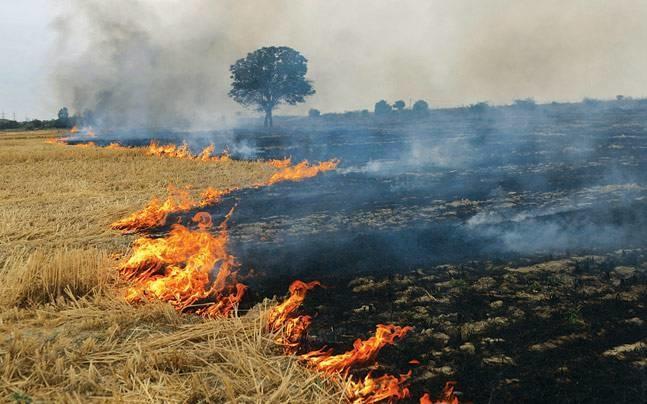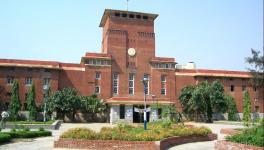Why Do Farmers Burn the Crop Residue in Punjab?

Image Courtesy: India Today
CHANDIGARH: Giving National Green Tribunal (NGT) orders a cold shoulder, many farmers in Punjab, Haryana and northern Rajasthan have resorted to stubble burning this year as well. Punjab’s Remote Sensing Centre has estimated over 19,000 incidents of paddy straw burning in the state till October 29.
The issue of stubble burning has come to fore after majority of the farmers shifted to the use of machinery for harvesting the paddy crop in October and November leaving behind 8-12 inches of paddy straw.
Every year in Punjab, about 7 to 8 million metric tonnes of paddy residue is burnt openly. Toxic chemicals, which result in respiratory problems, are released in the atmosphere. Farmers burn the paddy stubble as it involves no cost. Burning fields also affects the quality of the soil, robbing it of vital nutrients.
The national capital is the most affected by bad air quality as it lies close to Punjab and Haryana where paddy burning is a common phenomenon.
Though erring farmers have been warned by the state authorities, they continue with this practice.
The NGT had given directions to the district administrations to levy fine on the farmers found burning stubble. The NGT allows a fine of Rs 2,500 on stubble burning in two-acre land, Rs 5,000 fine in land measuring 2-5 acres, Rs 7,000 fine in land up to 10 acres and Rs 15,000 fine on burning stubble in fields above that measurement. Farmers also run the risk of losing the subsidy extended by the governments.
The farmers have time and again blamed the state government for denying financial assistance for stopping stubble burning. As per the order, for stopping stubble burning, the state government has to provide Rs 200 per quintal to farmers as bonus or financial assistance which has been denied so far.
28 year old farmer Rachpal Singh says use of machines for harvesting has serious implications on crop residue management at the farm level. The combine harvester cuts the crop well above the ground, leaving behind substantial amount of stubble. The machine leaves the stubble in such a state that it is difficult to collect them manually.
“The stubble left on the land is of no use. Currently, for farmers, it has no economic value and no nutritional value to be used as the fodder,” Singh adds.
Prahlad Singh, Head of the Department of Veterinary Gynaecology and Obstetrics, Guru Angad Dev Veterinary and Animal Sciences University (GADVASU), says unlike other states rice straw is not used as fodder in Punjab and Haryana.
“Rice straw in Punjab and Haryana has high silica content and thus it is non-palatable to animals. If the stubble is used as fodder it impacts the quality of milk. The quantity of calcium in milk decreases by at least two percentage points if rice straw is used as fodder,” Prahlad Singh says.
Experts say due to little economic value of stubble as animal feed and other general uses, farmers are prompted to burn it on the field instead of incurring a high cost on collecting it.
Farmers say the governments passes the orders to stop stubble burning but no one has come to give a solution.
“Marginal farmers do not have alternatives for utilising the stubble effectively. Therefore, blaming only the farmers may not solve the problem of air pollution and there is a need to find sustainable technological solutions that can help farmers and simultaneously allow everyone to breathe clean air,” Prahlad Singh says, adding the remaining ash on the farm land also has an adverse impact on soil health.
However, when it comes to wheat residue, farmers run a chaff combine after the combine harvest to collect the straw. They are then moulded into chaff for feeding to animals directly or mixed with green fodder. So the burning of wheat residue is not necessary for the farmers because of the availability of technology and its higher economic value as dry fodder.
The stubble can be used in paper and cardboard industry. However, both the industries have other raw materials which are cheaper and available around the year.
“The time gap between Rabi planting and Kharif harvesting is between two to three weeks. During this time, farmers clear the fields and ready them for the winter wheat crop. We are already held-up with so much of work, reaching out to customers for taking the residue is a tough task,” Amlok Singh, farmer from Bathinda says.
According to Harpal Singh, an assistant Professor in Department of Agriculture at Baba Farid Group of Insititutes, there is an immense opportunity of using the stubble in paper and cardboard industries but the conditions are not right.
“There are machines in market which cost around 10 lakh rupees. They can cut the residue but farmers have already invested a lot on mechanisation in the recent years. We can’t expect them to invest on machines which cut the paddy stubble when they are fighting for their survival,” Harpal Singh says
Farmers like Amlok Singh are advocating that if government provides subsidy for machines which cut rice stubble, situation could improve to some extent.
“It is economical to pay the penalty than to invest on cutting the stubble and fine is a small price compared with the cost of alternative equipment,” Amlok says.
The problem here can come as blessing in some other states which face shortage of the fodder.
“At times there is shortage of fodder for livestock in various regions of Rajasthan. Punjab and Haryana can process the stubble, which can be supplied there,” Prahlad Singh suggests
Disclaimer: The views expressed here are the author's personal views, and do not necessarily represent the views of Newsclick.
Get the latest reports & analysis with people's perspective on Protests, movements & deep analytical videos, discussions of the current affairs in your Telegram app. Subscribe to NewsClick's Telegram channel & get Real-Time updates on stories, as they get published on our website.
























